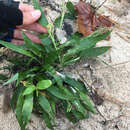Comprehensive Description
provided by North American Flora
Paspalum langei (Fourn.) Nash
Dimorphosiachys Langei Fourn. Mex. PI. Gram. 14. 1881.
Dimorphostachys Drummondii Fourn. Mex. PI. Gram. 15. 1881. Not P. Drummondii C. Miill.
1861. Paspalum Drummondii Vasey, Contr. U. S. Nat. Herb. 3 : 18. 1892. Paspalum oricola Millsp. & Chase, Field Columb. Mus. Publ. Bot. 3 : 28. 1903.
A nearly glabrous branched perennial, with flat leaf-blades and pubescent spikelets. Stems 3-7 dm. tall, glabrous; leaf -sheaths glabrous, excepting the ciliate margin; blades up to 2 dm. long, 8-15 mm. wide, erect, glabrous, sometimes ciliate, or with a few scattered hairs on the upper surface; racemes 2-4, rarely more, 4-9 cm. long, the rachis about 0.5 mm. wide; spikelets in pairs, 2-2.3 mm. long and about 1.5 mm. wide, obovate or elliptic, the first scale small, nerveless, rarely wanting in the upper spikelet, the second rather strongly pubescent, the third 5-nerved, glabrous, the fruiting scale roughened with longitudinal rows of papillae.
Type locality : Hacienda de Jovo, Vera Cruz. Distribution : Louisiana to Mexico and Guatemala.
- bibliographic citation
- George Valentine Nash. 1912. (POALES); POACEAE (pars). North American flora. vol 17(2). New York Botanical Garden, New York, NY
Comprehensive Description
provided by North American Flora
Paspalum ciliiferum (Nash) Hitchc. Contr. U. S. Nat
Herb. 12 : 201. 1909.
Dimorphosiachys ciliifera Nash, in Small, Fl. SK. U. S. 78. 1903.
A tall branched perennial, with pubescent ciliate flat leaf-blades, and pubescent spikelets. Stems glabrous, or sometimes papillose-hirsute toward the apex, 7-11 dm. tall; leaf-sheaths cihate, otherwise glabrous, or the lower ones papillose-hirsute; blades up to 3 dm. long and 1.5 cm. wide, erect or nearly so, ciUate, pubescent on the surfaces with scattered hairs; racemes 2 or 3, finally spreading, 7-9 cm. long, the rachis about 1 mm. wide; spikelets crowded in pairs, 2,5-2.8 mm. long and about 1.8 mm. broad, the first scale glabrous, very small or sometimes one half as long as the spikelet and acuminate, nerveless, or in the larger ones l-nerved, the second and third scales 5-nerved, the second glabrous, the third pubescent with short appressed hairs, the fruiting scale roughened with longitudinal rows of papillae.
Type locality ; Manatee, Florida. Distribution : Florida and Cuba.
- bibliographic citation
- George Valentine Nash. 1912. (POALES); POACEAE (pars). North American flora. vol 17(2). New York Botanical Garden, New York, NY
Physical Description
provided by USDA PLANTS text
Perennials, Terrestrial, not aquatic, Stems nodes swollen or brittle, Stems erect or ascending, Stems caespitose, tufted, or clustered, Stems terete, round in cross section, or polygonal, Stem internodes solid or spongy, Stem internodes hollow, Stems with inflorescence less than 1 m tall, Stems, culms, or scapes exceeding basal leaves, Leaves mostly cauline, Leaves conspicuously 2-ranked, distichous, Leaves sheathing at base, Leaf sheath mostly open, or loose, Leaf sheath smooth, glabrous, Leaf sheath hairy, hispid or prickly, Leaf sheath and blade differentiated, Leaf blades linear, Leaf blades 2-10 mm wide, Leaf blades 1-2 cm wide, Leaf blades mostly flat, Leaf blades mostly glabrous, Leaf blades more or less hairy, Ligule present, Ligule an unfringed eciliate membrane, Inflorescence terminal, Inflorescence solitary, with 1 spike, fascicle, glomerule, head, or cluster per stem or culm, Inflorescence a panicle with narrowly racemose or spicate branches, Inflorescence with 2-10 branches, Inflorescence branches 1-sided, Rachis dilated, flat, central axis to which spikelets are attached, Flowers bisexual, Spikelets pedicellate, Spikelets dorsally compressed or terete, Spikelet less than 3 mm wide, Spikelets with 1 fertile floret, Spikelets with 2 florets, Spikelet with 1 fertile floret and 1-2 sterile florets, Spikelets paired at rachis nodes, Spikelets all alike and fertille, Spikelets bisexual, Spikelets disarticulating below the glumes, Spikelets conspicuously hairy , Spikelets secund, in rows on one side of rachis, Rachilla or pedicel glabrous, Glumes present, empty bracts, Glumes 1 clearly present, the other greatly reduced or absent, Glumes 2 clearly present, Glumes distinctly unequal, Glumes equal to or longer than adjacent lemma, Glume equal to or longer than spikelet, Glumes 3 nerved, Lemma similar in texture to glumes, Lemma 3 nerved, Lemma glabrous, Lemma apex truncate, rounded, or obtuse, Lemma awnless, Lemma straight, Palea present, well developed, Palea shorter than lemma, Stamens 3, Styles 2-fid, deeply 2-branched, Stigmas 2, Fruit - caryopsis.

